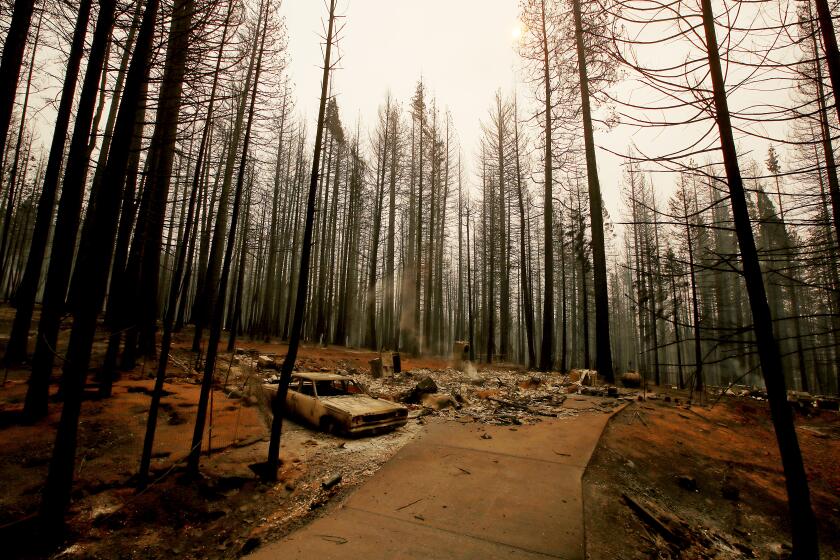Amid unprecedented fire season, L.A. officials urge residents to be prepared

- Share via
With more than 1 million acres burned across California already in 2021, Los Angeles leaders on Monday urged residents to protect themselves and their property ahead of Southern California’s wildfire season.
Mayor Eric Garcetti, who appeared with Los Angeles Fire Chief Ralph Terrazas and City Councilwoman Monica Rodriguez, said property owners should clear brush around their homes and digitize important papers or keep them at the ready in case evacuation orders come.
“This should be a year-round enterprise, now that fires are year-round as well,” Garcetti said.
Although Northern California has already seen excessive wildfires this year, the southern part of the state’s fire season typically spans October through December. Some of the region’s most destructive blazes — including the Woolsey, Thomas, Creek and Skirball fires — ignited in November and December.
And fall is traditionally when the hot, dry Santa Ana and Diablo winds begin to blow, pushing those flames “like a freight train,” said Capt. Erik Scott, a spokesperson for the Los Angeles Fire Department.
California faces unprecedented dangers as record heat, dryness combine with fierce winds
Flames have charred more than 1.54 million acres across California, surpassing the acreage burned at this point last year — and it’s still relatively early. Much of California is tinder dry amid an exceptional drought, and the conditions have parched vegetation to the point where it is primed to burn — and fast.
In 2020, wildfires seared more than 4 million acres across the state, a figure that doubled the previous record.
“And this year, we’re on path to surpass that record,” Scott said Monday.
More than 13,000 fire personnel are attacking 13 large blazes, most in the northern part of the state, according to the California Department of Forestry and Fire Protection. Smoke from the blazes has driven down air quality far from the burn areas, at times prompting advisories hundreds of miles away.
The biggest of the fires — the monstrous Dixie fire, which has burned 725,822 acres north of Sacramento, is the second-largest wildfire in California history. The blaze, now 40% contained, leveled the Gold Rush town of Greenville and has destroyed more than 680 homes since igniting more than a month ago.
To the east of Sacramento, the explosive Caldor fire has destroyed more than 400 homes, primarily in the remote El Dorado County community of Grizzly Flats. Pushed by gusty winds, the fire surged past 100,000 acres over the weekend and continued to burn toward the southern part of Lake Tahoe. After growing unchecked for over a week, the fire is just 5% contained.
Two other blazes — the Monument and McFarland fires — ignited in late July and have charred more than 268,000 acres between them in the far northern counties of Trinity and Shasta.
Experts are concerned the fires might burn for several more months, fed by bone-dry fuels that are especially receptive to fire.
Anthony Scardina, a deputy regional forester for the U.S. Forest Service, said some of the large fires in the northern part of the state could burn into early December. Fires that ignite in Southern California in September could also smolder to the end of the year.
With more people moving into the wildland-urban interface, there’s potentially more life — and property — in harm’s way when fires spring up.
When seasonal winds slam into a wall of flames, they send embers flying.
“It’s really those ember casts that go a mile in front of the flame fronts that will land on a home,” starting a fire, the LAFD’s Scott said, adding that the bulk of the Woolsey fire’s destruction in 2018 — more than 1,600 structures burned — was caused by embers that ignited rather than from the fire’s direct path.
Residents can do their part to mitigate risks by “hardening” their homes in advance of a fire, he said, in part by clearing brush and creating what’s known as defensible space.
Officials on Monday also advised residents to have an emergency supply kit and to make a plan to reconnect with family members if separated. Locals can text the word “ready” to 888-777 to receive emergency updates from the city of Los Angeles about fires.
Rodriguez, who represents neighborhoods in the northeast San Fernando Valley, an area known for its equine community, suggested residents register their large animals with the city’s Animal Services Department.
“It’s important for us to be able to get the information to you and [tell you] how to safely evacuate your home in these hillside areas,” especially if you have equine large animals, Rodriguez said.
The Associated Press contributed to this report.
More to Read
Sign up for Essential California
The most important California stories and recommendations in your inbox every morning.
You may occasionally receive promotional content from the Los Angeles Times.
















